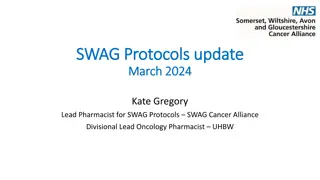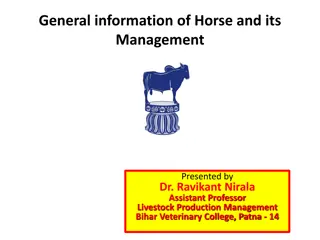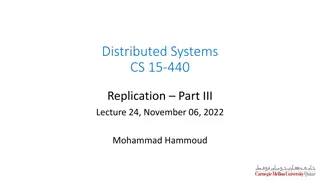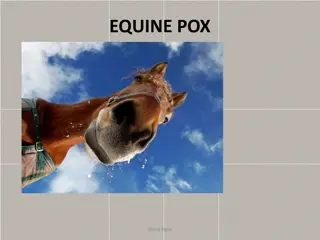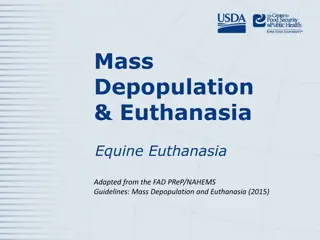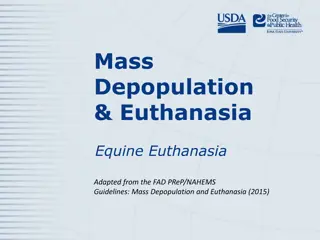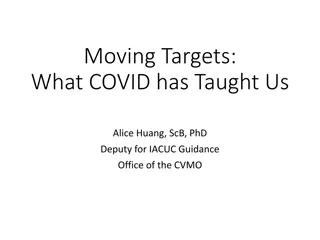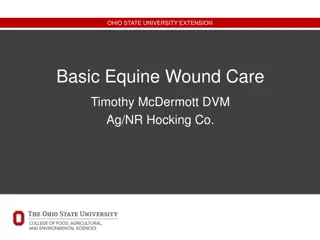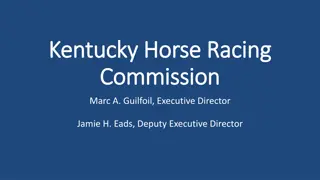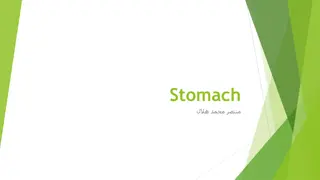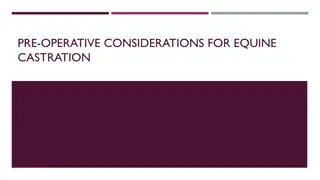Veterinary Update on Equine Worming Protocols
Explore the latest insights on equine worming practices, including details on common types of worms, clinical signs, prevention, treatment, and diagnostic methods. Learn about dealing with threadworms, tapeworms, pinworms, bots, and lungworms in horses and donkeys.
Download Presentation

Please find below an Image/Link to download the presentation.
The content on the website is provided AS IS for your information and personal use only. It may not be sold, licensed, or shared on other websites without obtaining consent from the author.If you encounter any issues during the download, it is possible that the publisher has removed the file from their server.
You are allowed to download the files provided on this website for personal or commercial use, subject to the condition that they are used lawfully. All files are the property of their respective owners.
The content on the website is provided AS IS for your information and personal use only. It may not be sold, licensed, or shared on other websites without obtaining consent from the author.
E N D
Presentation Transcript
Worming an update Katie Kershaw BVSc MRCVS
Plan The worms Worm control The wormers Resistance RDA
THE WORMS Helminths Nematodes Cestodes Arthropods Cyathostomins (small strongyles) Strongylus (large strongyles) Oxyuris equi (pin worm) Anoplocephala (tapeworm) Gasterophilus (bots) Strongyloides Parascaris
Strongyloids westeri Threadworm Age: Very young (birth 2 months) From the milk Clinical signs: Diarrhoea, lethargy, reduced weight gain Prevention: Treat mares before foaling? Treatment: Ivermectin
Tapeworms Anoplocephala perfoliata Age: 6 months + Pathology: Attach at ileocaecal junction Hyperaemia, mucosal thickening and necrotic ulcers Clinical Signs: Colic? No signs Treatment: Pyrantel Praziquantel Prevention: 1 or 2 treatments a year?
Tapeworm Diagnosis Faecal egg counts? Centrifugation? Flotation? Poor sensitivity/specificity ELISA Blood Uni of Liverpool and Rossdales Saliva Equisal Exposed in last 5 months
Pinworm Oxyuris equi Age: 5 months + Pathology: Irritant proteinaceous uterine fluid, egg masses or more complex? Clinical signs: Itchy bottom! Diagnosis: Protruding from rectum? Sticky tape - microscope NOT FEC Treatment: Wormer Cleaning, disinfection Prevention
Pinworm Lifecycle Crypts of Lieberkuhn Ventral Colon Right Dorsal Colon
Bots - Gasterophilus Age: any Clinical signs: Yellow dots on legs Significance? Treatment Ivermectin/moxidectin Autumn/Winter larvae in host
Lungworm Dictyocaulus arnfieldi Common in donkeys (supports the whole life cycle) Clinical signs Few in donkeys Coughing, breathing difficulties and inappetance in horses Diagnosis FEC Sedimentation Test the donkeys not horses (few adults in horses) Treatment Ivermectin/moxidectin
Liver Fluke Usually sheep and cattle Indirect life-cycle Galba truncatula Clinical signs: Weight loss/inappetance Raised liver parameters Diagnosis: FEC low sensitivity Serum ELISA unknown sensitivity/specificity Treatment: Triclabendazole 12mg/kg PO resistance?!
Large Strongyles Strongylus vulgaris Age: 6 months + Rare in UK now Denmark? Pathology: Migration intestinal wall Larvae in arterioles thromboembolic infarctions Clinical signs: Weight loss Colic Treatment: Most wormers no resistance known Prevention: Paddock maintenance
Small Strongyles Cyathostomins - Redworm
Clinical Signs Virtually ALL grazing horses exposed 5-10 common types None? Malaise Weight loss Anorexia Colic
The Encysted Stage L3 HYPOBIOSIS = early L3 Host immunity? Cold conditioning? Population density? Autumn/Winter Low/negative FEC Re-emergence Larval cyathostominosis Sudden weight loss, oedema, diarrhoea Fatal in up to 50% cases Spring
Diagnosis FEC Total protein + albumin on bloods Blood test (ELISA) for encysted? In development Many strains Immune response not current infection Autumn/Winter testing?
Treatment De-worming Ivermectin Moxidectin? Pyrantel Fenbendazole?! Anti-inflammatories? Fluid therapy?
Prevention Strategies Appropriate stocking Poo-picking > 2x/week Mixed grazing Separate dung heaps Pasture rotation? Survival 6-9 months - strongyles Years - ascarids Rest pasture Only in very hot weather Harrowing? Spread contamination Not hot enough to kill
Quarantine Moxidectin + Praziquantel on arrival Least evidence of resistance Quarantined 3 days post treatment Don t spread faeces FECRT after 10-14 days?
The Wormers Ivermectin Moxidectin Pyrantel Fenbendazole Praziquantel
How long to stable a horse after worming? Strongyles No need Unless environmental issues Parascaris 3 days?
Resistance Drug Cyathostomins Large Strongyles Full efficacy Ascarids Ivermectin Emerging resistance Emerging resistance Wide-spread resistance Wide-spread resistance Some resistance Wide-spread resistance Wide-spread resistance A few published cases Full efficacy Moxidectin Full efficacy Fenbendazole Full efficacy Oxibendazole Full efficacy Pyrantel Full efficacy A few published cases
Preventing resistance? Rotating products? Doesn t influence development of resistance Combining products? Doesn t influence development of resistance Refugia Only treating a select proportion of the population Only treat if high enough FEC?
Faecal Egg Counts The FEC does NOT directly correlate with number of worms Below 500epg number of worms likely to be low Determination of egg shedding Who is contaminating the pasture Useful in grazing season! FEC reduction testing Ascarids vs strongyles Clinical diagnosis? Larval stages!
Limitations Tapeworm ?? Pinworm Lungworm Liver fluke Cyathostomins in horses under 4 years Encysted cyathostomins (encysted red worm) In UK only encysted in Winter After first frost Blood test in development Post mortem
Costs? Savings 57- 568 per yard/year 18% horses required treatment High chance of reducing the financial costs
How to take a sample 3 x between March and September >3 faecal balls and mix Air-expelled container Refrigerate within 12 hours Tested within 5 days Quantitative technique Vet External lab
Interpretation Redworm vs Roundworm vs Tapeworm <200epg = LOW Doesn t currently require treatment 250epg 1200epg = MEDIUM Requires treatment 1200+ = HIGH May need additional or different treatments Discuss with own vet
Equisal Direct order from website Swab in mouth where bit sits Send away Tests for ANTIBODIES to the tapeworm +ve = exposed in last 5 months -ve = not exposed in last 5 months
Targeted Approach to Worming Spring FEC for ascarids and cyathostomins Equisal for tapeworm? Summer FEC for ascarids and cyathostomins Autumn FEC for ascarids and cyathostomins Equisal for tapeworm Winter Worm against encysted cyathostomins Test for resistance?
Westgate Labs Faecal Egg Count 5.50 + VAT ( 6.60) (Usually 9.95 per horse) Equisal 12 + VAT ( 14.40) (Usually 17.95 per horse) Per horse = 3 x FEC + 2 x Equisal = 48.60 Minimum = 2 x FEC + 1 x Equisal = 27.60 OR 2-3 x FEC then tape wormer in Winter with moxidectin (Equest Pramox)
Intelligent Worming Complementary worming MOT 25% off FEC 15% off wormers 50% off monthly fee ( 1 instead of 2 per horse)
The Veterinary Surgeon Many practices perform their own FEC Individual groups may wish to ask for prices/discount for charity themselves if used to using vets Many practices will be happy to discuss FEC from other companies if approached in the right way!
The Aim Create relationships with Westgate/IW Discounted FEC Discounted Equisal RDA specific form to encourage use Education programme of need for targeted worming
Thank you Lets come up with a plan



